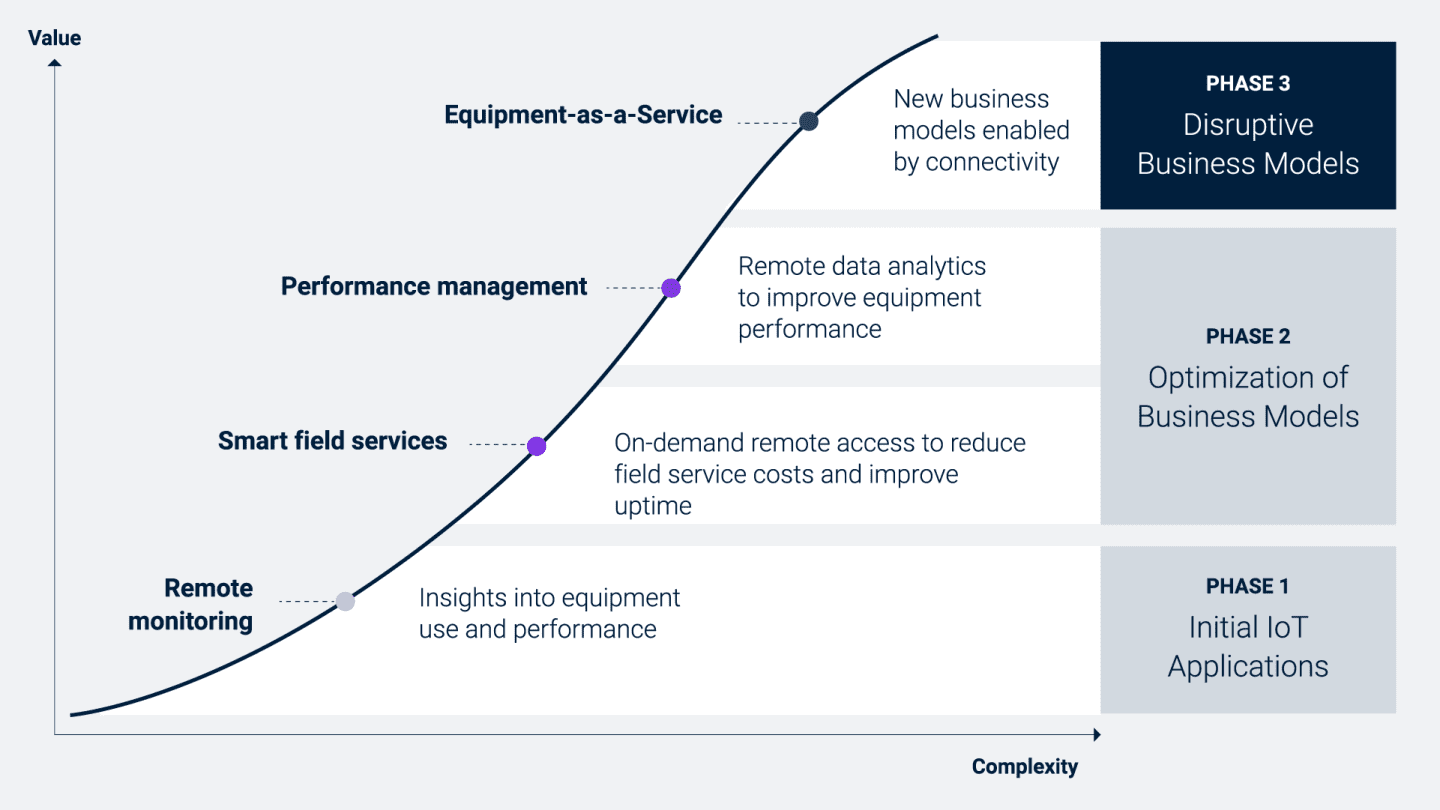4 steps to IoT value
How to climb the IoT maturity curve.

For equipment makers, the value of building smart connected products is clear: IoT helps you gain insights into how your products are used, predict when maintenance is needed, and boost machine performance. You realize a great physical product is no longer enough—instead, ‘as-a-service’ business models help you stay closer to customers and gain a competitive advantage by creating new revenue streams, new products and differentiating services.
So what’s the catch? Creating connected products goes far beyond technology. Creating new business models means changing your culture and building a new kind of relationship with customers.
Trying to jump from zero to hero is more likely than not to end with disappointment. In fact, for far too many companies, attempts to build connected products fall short. Currently, almost 75% of all IoT projects fail. Almost all of them (96%) don’t create new business models, 60% have scalability problems. Why?
Beecham Research’s survey of 25,000 IoT adopters found that IoT adopters tend to encounter common challenges:
- Business aims not thought out
- Company organizational issues
- Technological problems not foreseen
- Customer/vendor problems
Overcoming these challenges requires planning, experience and stakeholder buy-in. The good news is that building smart connected products isn’t an all-or-nothing proposition. In fact, the first step to IoT success is to think big, start small and move fast. This is why I’m so excited about how the IoT maturity curve can help guide equipment makers to take right-sized bites that, step-by-step, add up to a truly transformational outcome.


Let’s take a closer look at each step:
Unconnected products. Today, many equipment makers find themselves selling unconnected products, after which they only interact with it when a customer calls about a problem. This business model leaves them vulnerable to ever-shrinking margins on hardware and at a disadvantage to deliver new insights and services that help customers perform better.
1. Remote monitoring. IoT remote monitoring is the process of using connected devices to gain live insights into equipment use and performance. It’s a great place for equipment makers to start because it gives you the power to gain insights that accelerate development of new product features that matter most to customers. Connecting your products with an IoT platform also makes it easy to update software and firmware for security and stability.
2. Smart field services. Smart field services enable predictive and preventive maintenance. Once your devices are connected, you can use the data from IoT devices to tell when customer equipment needs servicing, and exactly what intervention is needed. Targeted services means technicians only visit when needed, and are ready to complete the job on the first visit. You reduce costs, while customers get greater uptime—increasing your value as a strategic partner.
3. Performance management. Performance management includes all the capabilities and operations you need to improve operational performance of key equipment. The most common metric used to define asset performance is Overall Equipment Effectiveness (OEE). With a rich stream of data from connected equipment, you can apply IoT data analytics to continuously improve the customer experience and create new outcome-based services based on improved uptime, lower energy consumption and more consistent output quality.
4. Equipment-as-a-Service. Also known as Product-as-a-Service, EaaS combines hardware and services into a single package. This model can help your customers lower their equipment Total Cost of Ownership and gain more flexible equipment costs that respond to changes in demand—customers ultimately pay for defined outcomes that better match their needs. EaaS helps you shift from reliance on shrinking hardware margins to more profitable after-sale services and parts. It’s also the last step on the maturity curve because it requires a fundamental shift in your business model away from the traditional sale of capital-intensive equipment.
The step-by-step approach to IoT maturity can help you achieve commercial success and faster time to value. Move at speed towards incremental, achievable targets that deliver new capabilities and value-added services at each stage—and avoid the common challenges that lead to IoT project failure.
Ready to start your journey, or move your way up the curve to smart connected products? Take a look at our eBook that shows how five successful businesses are creating more resilient revenue with IoT, or schedule a free demo of the Cumulocity IoT platform.